
Catalog excerpts

YoungStock Solutions Guidebook A guide to successfully rearing young animals engineering for a better world
Open the catalog to page 1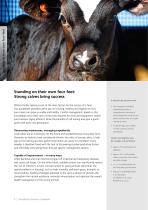
Standing on their own four feet: Strong calves bring success Efficient heifer rearing is one of the main factors for the success of a farm. Our guidebook provides useful tips on housing, feeding and hygiene so that your calves can grow up viable and healthy. Careful management, based on this knowledge and a clear view of the costs required for work and equipment, makes your business highly efficient: Draw the benefits of calf rearing and gain a good profit with each new generation! Discovering weaknesses, managing expediently Lively calves are an investment for the future and...
Open the catalog to page 4
When caring for calves, specifically targeted rearing management helps to cover the relatively long period of time up to the first calving. As an indicator for productivity, a daily gain in weight is a sign for a young animal in a good state of health. This results in an early age for the first calving which saves on costs, and dairy cows which achieve the best results in the long term: • Very good fertility • High milk yields • High lifetime performance Benchmarks table Worthwhile goals: successful rearing of young animals that pays off Focus on the costs Of course, every calf which is...
Open the catalog to page 5
For good upbringing - with systemDemands alter, depending on the age of the calves. The growth phases therefore form the structure of our guidebook. * The length of the colostrum phase may vary
Open the catalog to page 6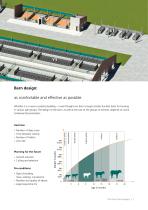
Barn design: as comfortable and effective as possible Whether it is a new or existing building – a well thought-out barn concept creates the best basis for housing in various age groups. The design of the barn, as well as the size of the groups of animals, depends on some fundamental parameters: Growth scenario Culling and selection Pre-conditions 0 months 50 kg • Type of building months 240 kg 6 2 months 32 (new, existing,1conversion)0 kg 15 months 400 kg • Number and quality of labour 24 months 600 kg Puberty phase Growth phase Rearing phase Number of dairy cows Time between calving...
Open the catalog to page 7
Colostrum phase 8 | YoungStock Solutions Guidebook
Open the catalog to page 8
Newborn calves are literally defenceless and are exposed to a high risk of infection directly after birth. The colostrum gives the necessary resilience regarding crucial diseases to the calf, because the mother's first milk is rich in immunoglobulins and protects against pathogens through blood circulation. The best conditions for the first days can be created with the use of calf hutches and individual boxes: Accommodation • Calves should be able to lie down under dry conditions • Protection against weather conditions (rain, snow and strong sun) • Free of draughts (no barns between two...
Open the catalog to page 9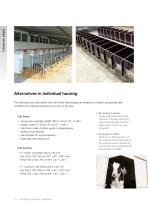
Colostrum phase Alternatives in individual housing The calf boxes and calf hutches from GEA Farm Technologies are flexible and mobile, and provide ideal conditions for individual housing at any time of the year. Calf boxes • • • • • • Various sizes available: Width: 80 to 120 cm (31" to 48") Length, interior: 130 to 215 cm (51" to 85") Side frame made of either wood or polypropylene Rolling frame optional Side window for social interaction Optionally with sliding roof Calf hutches • In “Small” size fitted with (L x W x H) box 150 x 120 x125 cm (59" x 47" x 49") and fence 150 x 120 x 95 cm...
Open the catalog to page 10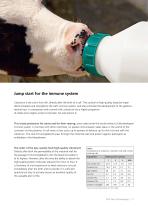
Jump start for the immune system Colostrum is the cow's first milk, directly after the birth of a calf. This cocktail of high-quality, bioactive ingredients initialises and strengthens the calf's immune system, and also promotes the development of the gastrointestinal tract. In comparison with normal milk, colostrum has a higher proportion of solids and a higher content of protein, fat and vitamin A. This is best protection for calves and for their rearing, since calves enter the world without a fully-developed immune system. In contrast with other mammals, no passive immunisation takes...
Open the catalog to page 11
Colostrum phase Successful start: Schedule for colostrum feeding Take advantage of the natural protective mechanism of colostrum for the start of calf rearing! Schedule (When?) • Feed freshly-milked colostrum within one hour, store cool for up to 24 hours or freeze in storage. • Slowly thaw out frozen colostrum and feed directly (preferably in a water bath, 40 °C (104 °F), a microwave may in some circumstances destroy the substances). Quantity (How much?) quantity to be fed depends on the quality of the colostrum. As a rule of thumb, you calculate 10 % of the body weight of the calf. • Use...
Open the catalog to page 12
Monitoring is the be-all and end-all It goes without saying that only colostrum from healthy cows should be used. It makes just as much sense to continuously monitor its quantity and quality. The immunoglobulin content of the milk can be easily, determined through its thickness with a colostrometer or refractometer. Experts test the passive immunisation of the calves by checking the blood serum, six hours after receiving the colostrum. A consumption of 3 l (0,8 G) gives, for instance, a content of 11,9 g/l of antibodies in the blood serum – a top value for strong growth. Health maintenance...
Open the catalog to page 13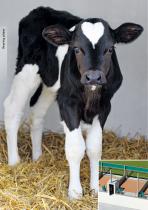
Rearing phase 14 | YoungStock Solutions Guidebook
Open the catalog to page 14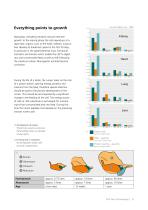
■ Protein quantity - quantity (per g of origin mass) Everything points to growth Nowadays, everything revolves around intensive growth: In the rearing phase the cells reproduce at a rapid rate, organs, such as the heart, kidneys, lungs or liver develop at breakneck speed in the first 50 days. In particular in the gastrointestinal tract, functional stomachs are formed, which enable the calf to digest raw and concentrated feed as well as milk following the colostrum phase. Monogastric animals become ruminants. During the life of a heifer, the rumen takes on the role of a power station,...
Open the catalog to page 15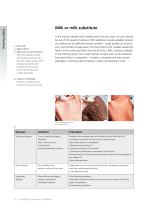
Rearing phase Milk or milk substitute 1 | Only milk 2 | Milk and hay 3 | Milk and concentrated feed The more papillae develop and the larger they are, the more the surface of the rumen develops and with it the capability of the rumen wall to absorb nutrients in large quantities. 4 | Sequence of feeding Progress in weekly phases: in quick steps up to weaning In the end you decide which product best suits your farm, but you should be sure of the quality in advance: Milk substitute is easily available, requires no cooling and has defined nutrient contents - good quality has its price, you must...
Open the catalog to page 16All GEA catalogs and technical brochures
-
GEA COWSCOUT
16 Pages
-
XPress
8 Pages
-
Vertical Chain Drive Unit
5 Pages
-
Intelligent cooling systems
20 Pages
-
Product range
153 Pages
-
Combiscraper
4 Pages
-
Twist&Lock
4 Pages
-
GEA DairyProQ
32 Pages
-
FRone
4 Pages
-
GEA DairyRobot R9500
15 Pages
-
IQLiner
2 Pages
-
Classic 300 & Classic 300 E
6 Pages
-
ClassicLiner SinglePiece
4 Pages
-
ClassicPro GQ
4 Pages
-
iC330 Milking Cluster
4 Pages
-
TopFlow S
4 Pages
-
TopFlow Z
4 Pages
-
Bucket-milking system
4 Pages
-
CowBrush 8S
8 Pages
-
GEAMixFeeder
4 Pages
-
DairyFarming AR Magnum 90
12 Pages






























